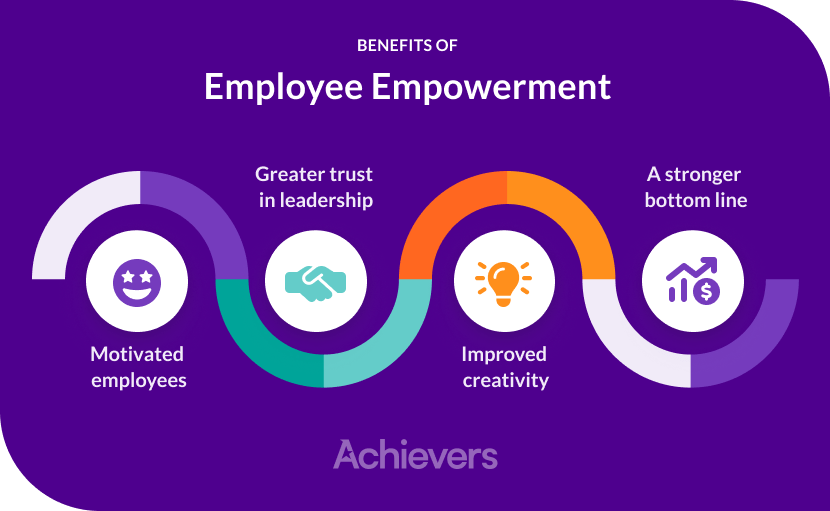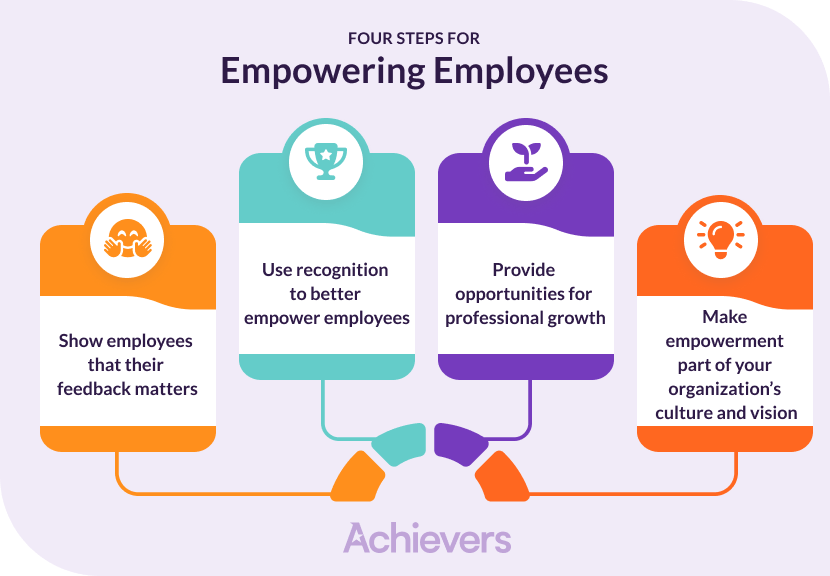Create a culture that means business™
Email address
A study of more than 7,000 employees showed that those employees who did not feel empowered were rated at the 24th percentile of engagement while those with a high level of empowerment came in at the 79th percentile.
Thankfully, with the right approach and tools, any organization can empower its employees. This article discusses the benefits of employee empowerment and explains how to start implementing best practices and embed employee empowerment into your company culture.
What is the definition of empowerment?
Empowerment is the act or action of empowering or enabling someone to perform certain acts or duties.
What is employee empowerment?
Employee empowerment is a management philosophy that focuses on allowing an organization’s employees to make independent decisions and to feel empowered to take action as they see fit. This is in contrast to micromanagement, which does not allow for independent decision making.
Companies that are interested in empowering employees should act on the following:
- Give employees a voice by regularly soliciting and acting on their feedback.
- Provide opportunities for employees to grow through more autonomy, additional responsibilities, or even an entirely new role.
- Recognize employees frequently to increase their engagement and confidence in their own abilities.
- And, of course, provide employees with the tools, training, and authority they need to excel.
A company’s leaders, HR professionals, and fellow employees all play key roles in establishing a supportive, empowered environment. All parties need to establish mutual trust, feel comfortable taking risks, and establish clear expectations and guidelines. Without this collaboration, truly empowering employees is impossible.
What are the 5 points of empowerment?
The five points, or ways to empower your employees starts with listening and recognition, and includes:
- Fostering an environment of trust and psychological safety
- Building employee confidence with recognition and incentives
- Offering flexibility in work arrangements
- Asking employees for feedback and actioning it
- Supporting professional growth with coaching and delegation

What are the benefits of employee empowerment?
- Motivated employees
- Greater trust in leadership
- Improved creativity
- Stronger bottom line
Employee empowerment can instill greater trust in leadership, encourage employee motivation, lead to greater creativity, and improve employee retention ー all of which ultimately results in a better bottom line.
Motivated employees
Empowering employees through greater autonomy has been directly linked to increased employee motivation. Experts agree that employees who have more control over how, when, and where they do their job will work harder and find their work more engaging. And given the chance to show off what they can do, employees will put their best foot forward and feel more satisfied at the end of the day.
Greater trust in leadership
A meta analysis published in Harvard Business Review states that leaders who empower their employees are more likely to be trusted by their subordinates compared to leaders who do not empower their employees. This is not to say that empowering employees involves pushing work onto underlings that managers don’t feel like doing themselves. Leaders who empower their employees act as coaches, pushing their employees to do their best work and supporting them along the way. Empowered employees felt that their leaders would not take advantage of their hard work ー instead, they would recognize and celebrate their wins.
Improved creativity
In the same Harvard meta analysis, leaders who were perceived as empowering had direct reports who were more likely to be rated by their colleagues as being highly creative. Unsurprisingly, subordinates who allowed their employees to think for themselves and collaborate across teams generated more novel ideas. Not only that, direct reports who felt empowered were more likely to volunteer for extra assignments and support their organizations outside of their day-to-day job function. Psychologists suspected that empowered individuals were more committed to meaningful goals, and used their creativity to achieve them.
A stronger bottom line
At the end of the day, companies that promote employee empowerment are simply performing better than those that don’t. Businesses with highly motivated workers are 21 percent more profitable. On the other hand, disengaged employees in the U.S. cost businesses a staggering $450 to $550 billion each year.
What does empowerment do for employees?
Empowering employees has several benefits, including:
- Increased levels of employee engagement
- Higher employee performance
- Better quality of work
- Elevated employee satisfaction
- Improved business results

How do you improve employee empowerment?
Improving employee empowerment provides the benefits discussed above.
Here are 8 tips on how to empower your employees:
- Delegate work responsibility based on role and skill set
- Set clear boundaries and expectations around when and how the work will be completed
- But be flexible, allowing employees to adjust their workday if needed
- Ensure employees have the resources they need to be successful
- Focus on the end results, not the process
- Be open to employee input to improve processes
- Support the development of soft skills
- Create a continuous learning environment
What are the advantages of employee empowerment?
There are many advantages to employee empowerment.
Some of the most impactful include:
- Greater motivation
- Higher productivity
- Enriched company culture
- More creativity in problem solving
- Confident decision making
- Reduced employee attrition
- More trust in leadership
- Improved customer experience
- A better brand experience for customers
- Better business outcomes
What are employee empowerment techniques?
There are several key ways to make employees feel empowered at work.
Be sure to incorporate the following into your best practices:
- Provide frequent feedback on their performance
- Ensure that it is honest and constructive
- Be clear and specific
- Ensure that you highlight what they did well/their strengths

4 steps for empowering employees in the workplace
- Show employees that their feedback matters
- Recognize to empower
- Provide opportunities for professional growth
- Make empowerment part of your organization’s culture and vision
There are tremendous benefits to empowering employees, but ingraining it in a company’s culture takes a considerable level of focus. Start implementing best practices throughout your organization by following these four steps.
1. Show employees that their feedback matters
Many companies distribute annual engagement surveys, but very few take the time to read employee comments, let alone act on them. Survey fatigue is a direct result of leadership not taking immediate action on feedback.
Encouraging employees to frequently provide honest feedback and actively changing your organization to fit their needs empowers employees by giving them a real voice in how the organization functions. In Achievers’ Engagement and Retention Report, 90 percent of workers said that they are more likely to stay at a company that takes and acts on feedback. HR and engagement leaders agree ー 64 percent say an always-on feedback tool is essential to an engagement listening program. However, only 20 percent use such a tool.
The timing and the manner in which a company collects feedback has a direct impact on the results received. Consider using an always on, employee-driven feedback tool such as a workplace chatbot so that employees can give feedback in the moment, in addition to pulse surveys .
Ensure you choose an employee feedback platform that shows leaders what drives their employees’ engagement via dashboards and heat maps that give real-time insights that provide guidance for any situation.
Feedback reveals how to effectively empower your workforce
Companies need to tailor their empowerment strategy to individual employees and their organizational culture. Take the time to determine what employee empowerment methods work best for your team members. Facilitating open, honest conversations between employees and leaders by using the right engagement solution is a key way to empower all team members and increase trust.
2. Recognize to empower
Recognition goes a long way and has been directly linked to higher empowerment. Brandon Hall Group’s Culture of Recognition Pulse Survey found that organizations with a high rate of employee recognition have more than double the employee engagement, and employees who work for a business that consistently recognizes its employees are 79 percent more likely to give their employer a high brand rating. Recognition improves motivation as well: 90 percent of employees say receiving recognition motivates them to work harder.
To empower employees through recognition, give them words of support, encouragement, and praise. Acknowledge their accomplishments so they know you’re invested in their success and trust them. Recognition from all levels ー from peers, to managers, to the C-suite ー is critical for establishing an empowering culture at your organization.
Recognizing behaviors that are in line with company values incentivizes employees to repeat them by empowering them with the confidence they need to live company values. 92 percent of workersagree that they are more likely to take a specific action again if they are recognized for doing it the first time. Using a recognition platform can foster an environment of empowerment, drive individual performance, and improve NPS scores and raise stock prices.
3. Provide opportunities for professional growth — and the necessary support
Professional growth and employee empowerment are highly interconnected. 87 percent of millennials – one third of the workforce – say that employee development is important in a job. But the need to focus on professional development is not limited by generation, as 40 percent of employees who receive poor training will leave their job within 5 years.
Invest in learning and development by urging employees to share their knowledge, take on new responsibilities, and attend industry conferences or events that gives them the power to learn and improve their skills. HR should also establish a clear path for career advancement at their company. Even if employees feel empowered, it can be discouraging to work towards an ill-defined or unattainable goal. Promoting employees in-house shows that growth and success has tangible rewards at your organization.
Companies also need to ensure there are plenty of coaching, mentoring, and training programs available to boost morale and offer a concrete sense of direction. And don’t neglect psychological safety, either, or employees won’t get much out of the relationship.
4. Make empowerment part of your organization’s culture and vision
Revamping your company culture to focus on empowering employees takes time and dedicated effort. According to Dr. Natalie Baumgartner, Chief Workforce Scientist at Achievers, “employees who feel ‘heard’ by leaders are 4.6 times more likely to feel empowered to do their best work,” and leaders must “find ways to recognize everyday behaviors that align with company culture and goals.” To create a culture of empowerment, leadership must realize its role to support employees, not the reverse.
All levels of your company need to feel empowered and set up for success, including HR, managers, higher-level leadership, and employees. Think of ways for existing employees to guide new employees through orientation, set up mentoring circles or idea exchanges, and brainstorm new and exciting ways for employees to engage with other departments.
Empowering employees produces a culture of continuity that can handle any changes thrown the organization’s way 一 even a global pandemic.

Empowering employees starts with listening and recognition
Companies need to find ways to empower employees in order to encourage and excite them. This makes employees feel as though they are meaningfully contributing to the company’s success and improves their emotional well-being.
Two of the main factors in empowerment are an openness to employee input and recognizing employees. Achievers Listen and Achievers Recognize can help jumpstart your company’s efforts towards employee empowerment. Achievers Listen allows your employees to provide feedback on their terms through frequent, anonymous pulse surveys and an always-on feedback channel. And it empowers managers as well by accelerating the feedback loop and providing them with the insights they need to take real-time action. Achievers Recognize empowers everyone in your organization to easily send monetary and social recognition to team members who exemplify your company values.
Both Achievers Listen and Achievers Recognize include detailed reports on KPIs that can be shared across the organization and provide critical guidance so you can take the right actions quickly.
Achievers empowers you to create the company culture you’ve always wanted.
Get started on your employee empowerment journey by downloading Achievers’ comprehensive guide or signing up for a free demo of Achievers Listen and Achievers Recognize today.
Discover the direct connection between employee recognition and employee retention

Start empowering managers to create a culture of appreciation

Learn how to empower leadership in the new world of work

Empowerment & trust: create a culture of feedback with employee listening
See the empowerment whitepaperStart empowering your leaders and employees with rewards and recognition software
Try the empowerment software demo
